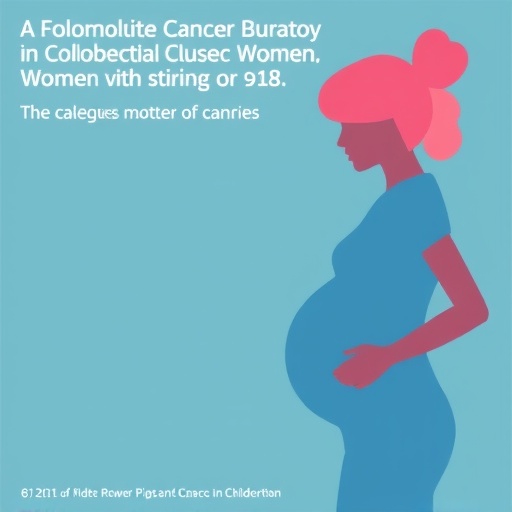
In a groundbreaking new analysis published in BMC Cancer, researchers have unveiled an alarming increase in the global burden of colorectal cancer (CRC) among women of childbearing age (WCBA) over the past three decades. This comprehensive study, drawing on data from the Global Burden of Disease (GBD) 2021 database, provides the most detailed and up-to-date evaluation of how colorectal cancer is impacting women aged roughly 15 to 49 worldwide. The findings underscore not only the rising prevalence of this malignancy but also highlight significant regional disparities and demographic challenges associated with this disease.
Colorectal cancer has long been recognized as a major public health issue, but its disproportionate impact on women in their prime reproductive years has gained greater attention only recently. Treatment regimens involved in CRC management—including surgery, radiation, and chemotherapy—carry the serious risk of fertility impairment and premature ovarian failure. This makes the increasing trend of CRC in WCBA particularly concerning, as the disease threatens both their health and reproductive futures.
The study utilized four primary epidemiological indicators—prevalence, incidence, mortality, and disability-adjusted life years (DALYs)—to quantify and analyze CRC burden globally from 1990 to 2021. By implementing Joinpoint regression models, the researchers detected temporal trends revealing a complex but telling pattern in disease dynamics over these three decades. While raw numbers for cases and deaths have more than doubled in this population, age-standardized rates offer a nuanced insight into underlying risk factors and healthcare responses.
Results indicate that the global number of women affected by CRC in 2021 was approximately twice the number seen in 1990, with prevalence, incidence, deaths, and DALYs all increasing significantly in absolute terms. However, when age-standardized metrics are considered, a divergent trend emerges: age-standardized prevalence rates (ASPR) have increased globally, whereas age-standardized incidence (ASIR), mortality (ASMR), and DALYs rates (ASDR) have shown gradual declines. This paradox suggests that more women are living longer with CRC, likely reflecting advances in diagnosis and treatment, even as the risk of new cases and deaths relative to age groups subtly improves.
Behind these trends lie critical demographic drivers. Decomposition analyses point to population growth and aging as dominant contributors to the rising burden of colorectal cancer among WCBA. As the global population expands and life expectancy increases, more women remain at risk for CRC, shifting the landscape of disease burden. This demographic impact is particularly pronounced because the cohort in question—women aged 15 to 49—spans a critical reproductive window traditionally considered lower risk for cancer.
Interestingly, the study also highlights a stark socioeconomic gradient in CRC burden. Utilizing the Social Development Index (SDI) and concentration indices, researchers demonstrated that higher SDI regions bear a disproportionately higher burden of CRC in WCBA. More developed countries and regions are experiencing greater age-standardized prevalence of colorectal cancer compared to their less developed counterparts. This finding potentially reflects complex interplay among lifestyle factors, screening practices, healthcare access, and disease awareness that vary across socioeconomic strata.
The rising burden in developed regions may be influenced by several lifestyle-related risk factors such as Westernized diets, sedentary behaviors, obesity, and alcohol consumption, all known contributors to colorectal carcinogenesis. Moreover, enhanced screening programs and improved diagnostic modalities in these regions might be detecting more cases earlier, contributing to increased prevalence rates but simultaneously improving survival outcomes, as suggested by decreasing age-standardized mortality and DALYs rates.
This study also sheds light on age-specific burdens within the WCBA population. Notably, the 45–49 age group has emerged as the most affected subgroup, highlighting a need for targeted awareness, screening strategies, and healthcare resource allocation to this demographic. Given that colorectal cancer screening typically begins around 50 in many health systems, these findings prompt reconsideration of current guidelines to ensure earlier detection for at-risk younger women.
The implications of this research extend beyond epidemiology to clinical and public health practices. The dual challenge of managing increasing CRC prevalence while safeguarding fertility and reproductive health in women of childbearing age necessitates integrated care approaches. Collaborative international efforts and rationalized screening procedures are urgently needed to mitigate this growing threat, particularly as global population dynamics continue to evolve.
Frontier analysis performed in the study further evaluated the efficiency of regions in addressing CRC burden, indicating that some countries lag in optimizing healthcare delivery and preventive interventions. These inefficiencies emphasize the scope for policy reforms and investment to enhance the accessibility and quality of cancer care services for women in their reproductive years.
Moreover, the study period covering 1990 to 2021 encapsulates critical shifts in disease epidemiology, medical technology, and socioeconomic development worldwide. Such a longitudinal approach facilitates a holistic understanding of the evolving burden and points toward future trajectories and unmet needs in the fight against CRC among women of reproductive age.
The global oncology community can draw valuable insights from this comprehensive analysis. While progress in cancer therapeutics and early detection have curbed mortality to some extent, the sustained rise in absolute case counts calls for intensified preventive efforts emphasizing lifestyle modification, genetic counseling, and risk stratification tailored specifically for women of this age group.
The study’s reliance on the GBD 2021 database ensures robust data triangulation from multiple sources, enhancing the reliability and completeness of findings. Nonetheless, it also underscores areas where data paucity exists, urging further research into understudied populations and contextual risk factors that may influence colorectal cancer dynamics differently across various sociodemographic landscapes.
Critically, the documented inequality in CRC burden highlights the necessity of addressing social determinants of health as part of comprehensive cancer control strategies. Bridging the gap across countries and regions, especially where social development is uneven, will be vital to achieving equitable health outcomes for women worldwide.
In summary, this landmark analysis provides compelling evidence that colorectal cancer is increasingly compromising the health and reproductive potential of women globally. Its growing prevalence amidst shifting demographic and socioeconomic conditions calls for urgent, coordinated international actions encompassing prevention, early diagnosis, and personalized treatment protocols. As we move forward, prioritizing the needs of women of childbearing age in oncology policy and practice remains a pressing imperative.
—
Subject of Research: Burden of colorectal cancer among women of childbearing age globally from 1990 to 2021
Article Title: Global, regional, and national burden of colorectal cancer among women of childbearing age from 1990 to 2021: a systematic analysis based on the global burden of disease study 2021
Article References: Li, X., Zhou, X., Chen, Y. et al. Global, regional, and national burden of colorectal cancer among women of childbearing age from 1990 to 2021: a systematic analysis based on the global burden of disease study 2021. BMC Cancer 25, 1389 (2025). https://doi.org/10.1186/s12885-025-14802-9
Image Credits: Scienmag.com
DOI: https://doi.org/10.1186/s12885-025-14802-9
Tags: cancer incidence in womenchildbearing age cancer statisticscolorectal cancer in womenCRC prevalence in young womendemographic challenges in cancer careepidemiological indicators for cancerfertility implications of cancer treatmentglobal burden of disease colorectal cancermortality rates of colorectal cancerpublic health and women’s healthregional disparities in colorectal cancerreproductive health and cancer




